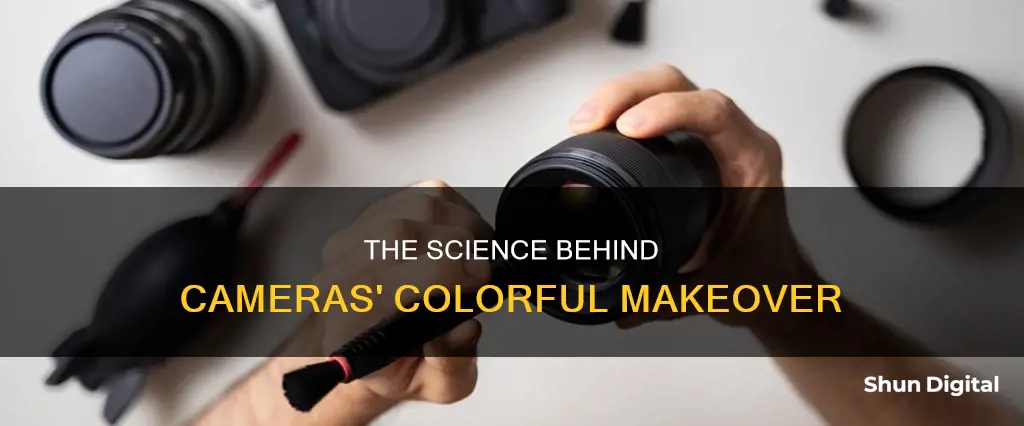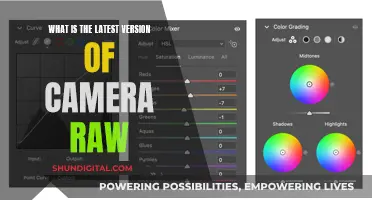
The colours in a photograph are determined by the camera's image sensor and the light it receives, as well as the software used to process the image. Different cameras and different software will produce different colours, and even the same camera and software setup will produce different colours when photographing different objects. This is because cameras see light differently to the human eye, and because of the way that light interacts with different materials.
| Characteristics | Values |
|---|---|
| Camera colours | Different colours appear differently to a digital camera than to the human eye. |
| Digital cameras | Digital cameras record light as digital data. |
| Film cameras | Film cameras have different sensitivities. |
| RAW files | RAW files don't include inherent colour values. |
| JPEG files | Cameras process JPEG files in-camera and apply specific colour toning depending on selected settings. |
| RAW processing software | RAW processing software and an image sensor's response to light influence the colours in the final image. |
| Colour accuracy | No camera, in conjunction with a RAW developer, is perfectly optimised to deliver accurate colour. |
| Memory colours | Memory colours, like the blue sky or skin tones, are artificially altered by cameras to make colours appear more accurate and lifelike. |
| Colour profiles | Photographers can select from different colour profiles, like Adobe Standard, Adobe Colour, Adobe Portrait, Adobe Landscape, and Adobe Neutral. |
| Camera differences | Cameras see colour differently due to differences in the camera itself, software processing, profiles, and image sensors. |
| Individual perception | Individuals experience colour differently via complex physical and psychological processes. |
What You'll Learn

Cameras see colour differently to the human eye
The camera lens is like the human eye, and the camera sensor is its retina. Cameras use sensors to capture colour, and these are made up of an array of tiny light-capturing photosites. These collect photons from light and store them as electrical signals. The signals are then turned into digital signals and recorded.
A filter is placed on the sensor, using the three primary colours: red, green, and blue (RGB). These colours are processed according to their channel, and each pixel contains three channels represented by the three colours. This is known as the Bayer Array filter.
The human eye is more sensitive to green light, so the Bayer Array has one more representation of green than red or blue. The green channel contains the most detail and the least noise, while the blue channel is the noisiest due to its shorter wavelength of light.
Cameras with long exposures can bring out more colour than the human eye can perceive in low-light settings. The human eye is also less sensitive to colour in low-light settings. Cameras, on the other hand, always have the same sensitivity.
Digital cameras record light as digital data, and unlike film, digital images do not deteriorate with age.
Charging Your Alto Camera: A Quick Guide
You may want to see also

Different cameras see colour differently
The human eye sees colour differently from digital cameras. This phenomenon is called metamerism. The eye has three types of cones, each stimulated by blue, green/yellow, and red/yellow light. This means that we have better vision in the warmer part of the spectrum.
Digital cameras, on the other hand, do not have this limitation. They can perceive colours that the human eye cannot. This is because cameras have sensors that detect the wavelength of each hue and translate this digitally on the screen.
For example, a camera may detect different hues of the same colour, which the human eye would perceive as the same. This is why the same image or object can appear different when captured by two different cameras.
In addition, the type of light and the medium on which the image is viewed can also affect how colour is perceived. For instance, watercolour paintings are illuminated from the back when digitised, whereas they reflect light in real life. This can result in a 30-40% decrease in image quality.
Where to Buy Camera Batteries: Walgreens and Beyond
You may want to see also

Different camera brands have different 'colour science'
The colours in a photograph are determined by how the camera renders them. Different camera brands have different colour sciences, which is why the same scene can look different when photographed by cameras from different brands.
For instance, Sony is famous for being the most accurate, while Canon is known for its pleasing skin tones. Canon's colour science manages to make all Caucasian and many Japanese/Asian skin colours look almost the same shade of pink. Wedding photographers liked the Canon results because all the people in a group tended to look much the same.
The rendered output is determined by the Bayer RGB colour array sitting on top of the sensor, plus the demosaicing algorithm essential to creating the colour image.
The sensors in cameras have gotten so close to each other that the colour is very similar. It is not hard to correct colours in post-processing. You can create a preset, especially using the Spyder Checkr Photo, that you can apply to another camera to be able to get it very similar to, say, a second shooter's camera at a wedding.
Auto Mode: Your Camera's Smart Default Setting
You may want to see also

RAW processing software impacts colour
The colours in the final image of a photograph are influenced by the RAW processing software and the image sensor's response to light, with the former having a larger impact. The software's colour profile is particularly important.
While JPEG files are processed in-camera and have specific colour toning applied, RAW files do not include inherent colour values. This means that the colours in a RAW image are determined by the software used to process the file.
Different RAW processing software will produce different results, even when no adjustments are made. For example, a test comparing Nikon's NX Studio, Adobe Lightroom Classic, Adobe Lightroom Creative Cloud, Affinity Photo 2, Capture One, and Darktable found that each produced a different result in terms of file size, image brightness, contrast, saturation, and resolution.
Therefore, it is important to experiment with different RAW processing software to find the one that best suits your needs and preferences.
Camera Batteries: How Long Do They Really Last?
You may want to see also

Memory colours are altered to seem more accurate
Memory colours are those that, in the minds of the audience, are inseparable from certain common objects or events. For example, the sky is so associated with blue that you might feel that you see those two words together as often as you see them individually. The same goes for green and grass. These colours are so ingrained in our minds that we "auto-correct" for them, even when the colour is way off.
In the realm of photography and cinematography, memory colours are altered to seem more accurate. This is done through a process called colour correction or grading. The goal is to make objects on the screen appear to be the colours that we know them to be. For instance, preserving appealing skin tones is crucial, as is ensuring that other memory colours, such as the vivid red of brake lights or the yellow-orange of New York taxis, remain intact.
The challenge lies in achieving the desired look while maintaining the accuracy of these memory colours. Lighting, atmosphere, camera settings, and various other factors can cause objects to render on-screen in colours quite unlike their real-world hues. It takes skill and practice for a colourist to first select the memory colours important to a scene and then ensure they stay consistent.
For example, in a shot from the film *Jumper*, the world is depicted in a faded, monochrome olive drab. Yet, within this scene, brake lights shine a perfect, vivid red, and New York taxis retain their characteristic yellow-orange hue. This memory colour preservation helps convey the setting of New York to the audience.
In another instance, a photographer noticed that footage of espresso beans, which are typically a vivid, sumptuous brown, appeared grey-black on the screen due to the cool colour temperature of the lighting. To address this discrepancy, the colourist would need to recreate the memory colour of perfectly roasted coffee beans to communicate the correct visual message to the audience.
By altering memory colours to be more accurate, colourists enhance the visual storytelling and ensure that the audience's knowledge of colours aligns with their experience.
How Shooting Raw Impacts Your Camera's Performance
You may want to see also
Frequently asked questions
Digital cameras see light differently from the way the human eye does. Cameras can pick up on details that the human eye can't see.
The camera sees and records things in a painting that the eye either doesn't see or ignores. The camera doesn't have the same limitations as the human eye when it comes to discerning colours.
The screen of a camera occupies a much smaller field of view than a painting normally does, so it's like sticking your nose into the painting and seeing details that aren't meant to be seen from close range. The lighting conditions under which a photo is taken can also affect how colours appear on a camera screen.
Cameras are calibrated to have the colours in an image match the colours in a scene, but sometimes colours must be "wrong" in order to appear "right" to colour-normal viewers. Memory colours, like the blue sky or someone's rich skin tones, are artificially altered by cameras to make colours appear in a way that seems more accurate and lifelike, even though they aren't.
You can adjust the white balance on your camera and calibrate your monitor to ensure that the colours in your photos are displayed accurately. If you're shooting in RAW format, you can also adjust the colours during post-processing using software like Adobe Lightroom or Adobe Camera Raw.







